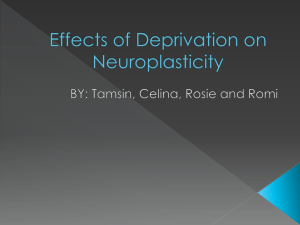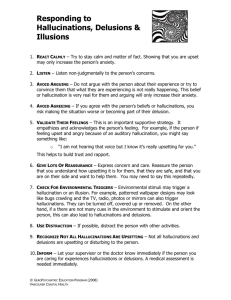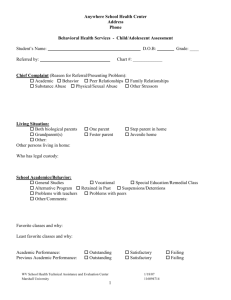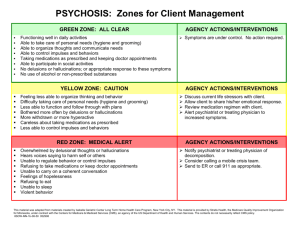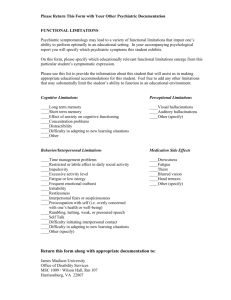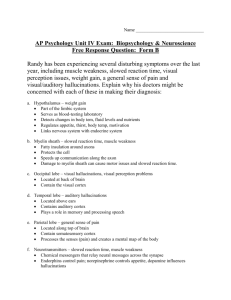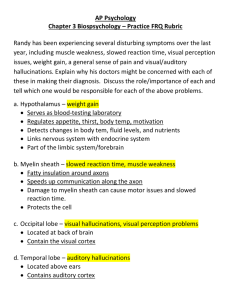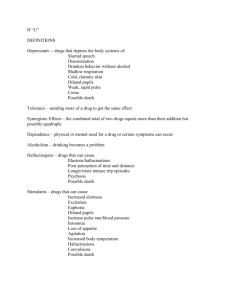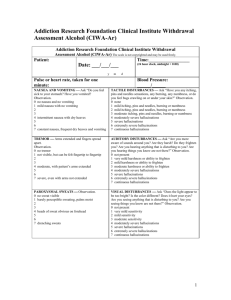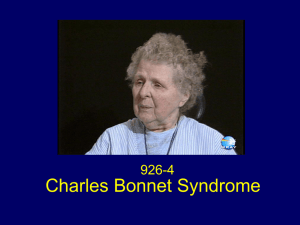Hallucinations - Queensland Health
advertisement
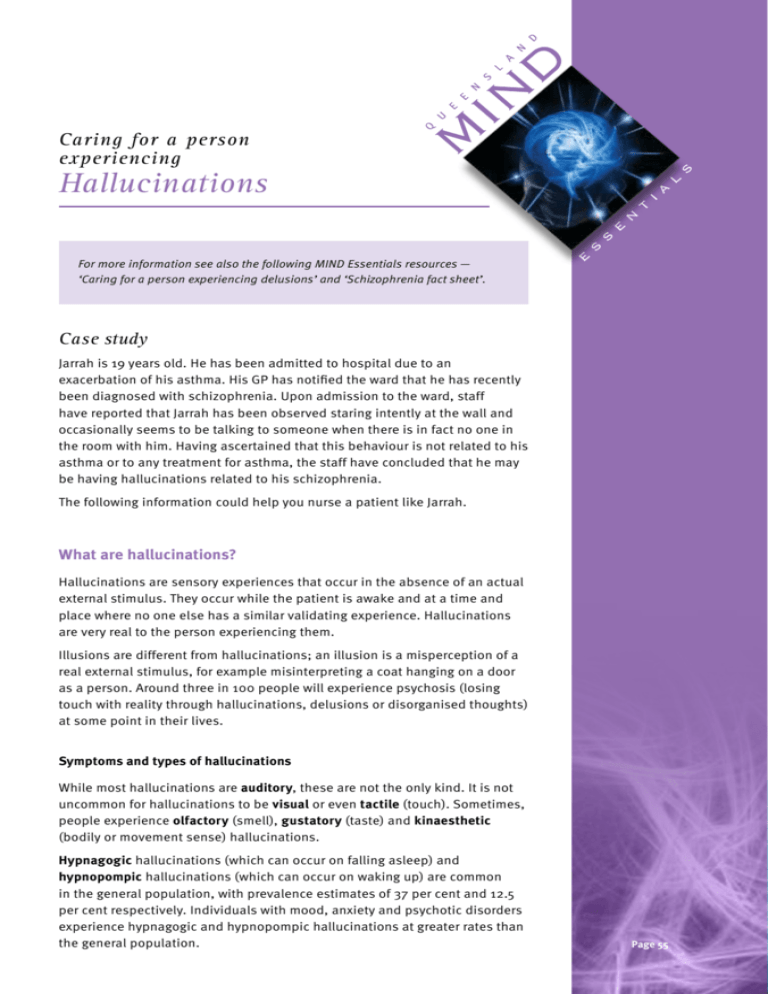
Caring for a person experiencing Hallucinations For more information see also the following MIND Essentials resources — ‘Caring for a person experiencing delusions’ and ‘Schizophrenia fact sheet’. Case study Jarrah is 19 years old. He has been admitted to hospital due to an exacerbation of his asthma. His GP has notified the ward that he has recently been diagnosed with schizophrenia. Upon admission to the ward, staff have reported that Jarrah has been observed staring intently at the wall and occasionally seems to be talking to someone when there is in fact no one in the room with him. Having ascertained that this behaviour is not related to his asthma or to any treatment for asthma, the staff have concluded that he may be having hallucinations related to his schizophrenia. The following information could help you nurse a patient like Jarrah. What are hallucinations? Hallucinations are sensory experiences that occur in the absence of an actual external stimulus. They occur while the patient is awake and at a time and place where no one else has a similar validating experience. Hallucinations are very real to the person experiencing them. Illusions are different from hallucinations; an illusion is a misperception of a real external stimulus, for example misinterpreting a coat hanging on a door as a person. Around three in 100 people will experience psychosis (losing touch with reality through hallucinations, delusions or disorganised thoughts) at some point in their lives. Symptoms and types of hallucinations While most hallucinations are auditory, these are not the only kind. It is not uncommon for hallucinations to be visual or even tactile (touch). Sometimes, people experience olfactory (smell), gustatory (taste) and kinaesthetic (bodily or movement sense) hallucinations. Hypnagogic hallucinations (which can occur on falling asleep) and hypnopompic hallucinations (which can occur on waking up) are common in the general population, with prevalence estimates of 37 per cent and 12.5 per cent respectively. Individuals with mood, anxiety and psychotic disorders experience hypnagogic and hypnopompic hallucinations at greater rates than the general population. Page 55 Page 55 Hallucinations Hallucinations may be accompanied by varying degrees of anxiety and distress. The level of anxiety relates to the degree of influence the hallucination has on the person’s behaviour. At the lowest level, the person may be preoccupied but able to manage thoughts and emotions, and able to interact with others. At a moderate level, severe anxiety occurs, and the hallucinatory experience feels repulsive and frightening. The person begins to feel out of control and embarrassed, and withdraws from others. At the extreme level, the person may experience a degree of panic, feel threatened by their thoughts and compelled to follow commands. The person will find it difficult to follow directions or may be unable to pay attention to more than one thing at a time. Causes of hallucinations People may experience hallucinations due to a range of causes, including: u imbalance u extreme in brain chemistry starvation u substance use and withdrawal u dementia u schizophrenia u fever u post-traumatic stress disorder u psychotic depression u delirium u obsessive compulsive disorder Difficulties in diagnosis It is important to establish the likely cause of the hallucinations. Even when a person has a diagnosis of mental illness such as schizophrenia, in the hospital setting it is important to regularly assess whether the hallucinations could be due to other causes. A person’s perspective on what is it like to experience hallucinations ‘From the minute I woke up until I went to sleep, or at least tried to sleep, I could hear the voices. Sometimes they were in the background muttering away and other times they’d be screaming at me saying horrible stuff. It was like I was constantly the centre of attention in a group when all I wanted was to be left alone.’ Some reported reactions to people who are experiencing hallucinations Nurses who have worked with people who are hallucinating have reported the following reactions: Disregard Nurses may assume that complaints of physical discomfort are part of the hallucination and so may not take the time to investigate the problem. Amusement A common (but unhelpful) reaction to a person who is hallucinating is for a nurse to be amused at his or her behaviour. Anxiety Some nurses report experiencing anxiety due to the person’s unpredictable behaviour. Inadequacy Nurses may feel that it is beyond the range of their skills to effectively intervene. Avoidance A nurse might experience a desire to avoid such patients due to a lack of confidence, insufficient knowledge or difficulties in engaging with the person. Page 56 Goals for nursing the person who is experiencing hallucinations u Develop a relationship with the person based on empathy and trust. u Promote an understanding of the features and appropriate management of hallucinations. u Promote effective coping strategies for anxiety, stress or other emotions which may act as triggers for hallucinations. u Promote positive health behaviours, including medication compliance and healthy lifestyle choices (for example, diet, exercise, and/or not smoking). u Promote Hallucinations Appropriate goals in a community or hospital setting when caring for a person who is hallucinating include: the person’s engagement with their social and support network. u Ensure effective collaboration with other relevant service providers, through development of effective working relationships and communication. u Support and promote self care activities for families and carers of the person experiencing hallucinations. Guidelines for responding to a person who is experiencing hallucinations u Arrange for a review of the person’s medication for hallucinations and an initial or follow-up psychiatric assessment if their care plan needs reviewing. A mental health assessment may be appropriate to undertake — see the MIND Essentials resource ‘What is a mental health assessment?’. u A person’s cultural background can influence the way symptoms of mental illness are expressed or understood. It is essential to take this into account when formulating diagnosis and care plans. Indigenous mental health workers or multicultural mental health coordinators and the Transcultural Clinical Consultation Service from Queensland Transcultural Mental Health Centre are available for advice and assistance in understanding these issues. For more information visit www.health.qld.gov.au/pahospital/qtmhc/default.asp This is particularly important for apparent psychotic experiences in people who identify as Aboriginal or Torres Strait Islander. u Watch for cues that the person may be experiencing hallucinations. These include watching an empty space in the room with eyes darting back and forth, speaking to an invisible person, talking to himself or herself, and appearing to listen to someone when no one is speaking. u If your relationship is appropriate, directly ask the person whether he or she is experiencing hallucinations. For example, you could say: ‘Are you hearing voices now? Is it a man’s or a woman’s voice? What are they saying to or about you?’ It is not appropriate or necessary to repeat this questioning frequently. u It may be difficult for the person to concentrate on what you are saying because of the distraction of the hallucinations. Without being condescending, speak clearly and keep sentences simple. u Do not respond as if the hallucinations are real. For example, do not argue back to voices that the person may be hearing. u Do not deny the person’s experience, but suggest your own perceptions. For example, you could say: ‘I understand that you are feeling worried now. I don’t see or hear anything, but I can understand that it may be difficult, worrying or unpleasant for you’. u Remember that a person who is experiencing hallucinations is often able to distinguish between the hallucinations and reality. In such cases, the person can understand the conversations you are having. Page 57 u Help Hallucinations the person to identify symptoms, symptom triggers and symptom management strategies. For example, it may be helpful to ensure that the person has a well lit room and that extraneous noise is kept to a minimum. Explain unfamiliar equipment and noise in the environment and let the person know what the normal routine is. u Help the person to cope with auditory hallucinations by providing diversions. For example, you could make conversation or undertake simple projects or physical activity with the person. u Help the person to compare his or her thoughts and ideas with those of others to see if the impressions are similar (reality testing). u Hallucinations can take weeks, even months, to diminish fully, even if the person does respond to antipsychotic medication. Once the person has responded to medication and other treatment, he or she can live a full and normal life. Encourage the person to look forward to this. u Monitor recovery, compliance with medication and general physical health (including nutrition, weight, blood pressure etc.). Provide education on possible side effects to any medication and work with the person to develop appropriate actions to address any issues. u Provide family members and carers with information about hallucinations if appropriate, as well as reassure and validate their experiences with the person. Encourage family members and carers to look after themselves and seek support if required. u Be aware of your own feelings when caring for a person experiencing hallucinations. Arrange for debriefing for yourself or any colleague who may need support or assistance — this may occur with a clinical supervisor or an Employee Assistance Service counsellor. The Employee Assistance Service provides confidential, short-term counselling free-ofcharge to Queensland Health staff to assist them to resolve personal and work related problems. For more information visit http://qheps.health.qld.gov.au/eap/home.htm Treatment of hallucinations Psychosocial strategies and antipsychotic drugs may both be an important part of the person’s management regime. Psychosocial strategies including education, counselling and support for the person and his or her family can help with understanding, stress management and compliance with medication. Given that compliance with antipsychotic drugs may be an issue, you may need to provide close supervision. Discussion with the person about non-compliance may elicit suspicions. If so, inform the treating doctor, who may need to consider alternative treatment. Adverse effects to antipsychotic medication can occur. These may include: u sedation u anticholinergic effects — such as dry mouth, urinary retention and constipation u extrapyramidal effects — which include dystonias (painful muscle contractions or jerking movements that may cause airway obstruction), Parkinsonism (tremors and/or shuffling gait) and akathisia (restlessness and/or inability to sit still) u orthostatic u tardive Page 58 hypotension (fall in blood pressure when standing) dyskinesia (repetitive involuntary movements, which are usually irreversible) u agranulocytosis u photosensitivity lowered seizure threshold u Neuroleptic Malignant Syndrome (NMS) — a life-threatening condition that can occur in up to one per cent of people taking antipsychotics (symptoms include fever, extreme muscle rigidity and altered consciousness can occur hours to months after commencing or increasing drug therapy) Neuroleptic Malignant Syndrome needs to be treated as a medical emergency requiring cessation of the antipsychotic medication, reduction of body temperature, and cardiovascular, renal and respiratory support. Hallucinations u Management of minor side effects may involve altering the dose, change of medication or symptomatic management with monitoring and patient education. More severe side effects (such as dystonia) can be treated with an anticholinergic agent such as benztropine given IM or IV. Discharge planning Discuss referral options with the person and consider referrals to the following: u GP u Community Child Health u Community Health u Mental Health Services (infant, child and youth or adult) u Private service providers To access the contact numbers and details for your local services use QFinder (available on QHEPS) or call 13HEALTH (13 43 25 84). Further reading See also the Mental Health First Aid Manual at www.mhfa.com.au (internet access required). Sources Gorman, L. M., Sultan, D. & Luna-Raines, M. (1989). Psychosocial nursing handbook for the nonpsychiatric nurse. Baltimore: Williams & Wilkins. Plante, D. T. & Winkelman, J. W. (2008). Parasomnias: Psychiatric considerations. Sleep Medicine Clinics, 3 (2). Shives, L. R. (2008). Psychiatric — mental health nursing (7th ed.). Philadelphia: Lippincott, Williams & Wilkins. Stuart, G. W & Laraia, M. T. (2005). Principles and practice of psychiatric nursing (8th ed.). St Louis: Elsevier Mosby. Page 59
